How can we stimulate the vagus nerve in our yoga practice? Part 1
24Have you heard the term “stress loop” before? Here is how it works. When your mind perceives something dangerous or stressful it activates the sympathetic nervous system which dumps adrenalin and other stress hormones into your body, and your body responds – the blood pulls toward large skeletal muscles, you begin to breathe faster, and so on. So your body is now ready to “fight or flight” and sends a signal of readiness to your brain. The brain perceives that your body is wound up and interprets it as confirmation that there is real danger present and continues with the stress response, which, in turn, keeps the body in a fight-or-flight mode, which then sends those stress signals back to the brain – and so the cycle goes on and on.
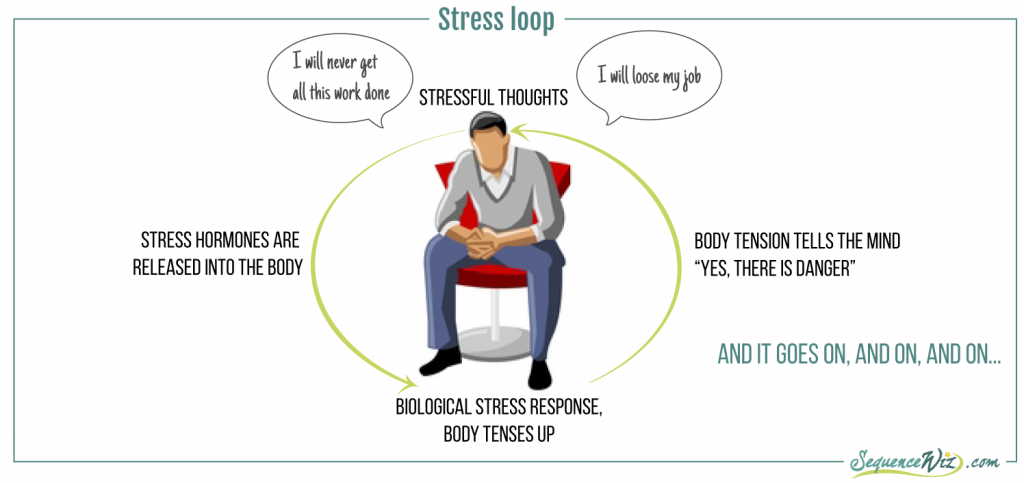 To break out of the loop you need to activate your parasympathetic nervous system (the rest-and-digest mode), and there are two ways to do it – to convince your mind that there is no more danger or to stop the biological stress response so that the body signals the mind that it is no longer in a fight-or-flight mode. What’s important to us here is that the vagus nerve would communicate both of those messages since it is responsible for most of parasympathetic messaging both from the brain to the body and from the body to the brain. And since 80% of its fibers communicate the information from the body to the brain, one could argue that the state of the body (whether it’s agitated or calm) has a great impact on the state of the mind.
To break out of the loop you need to activate your parasympathetic nervous system (the rest-and-digest mode), and there are two ways to do it – to convince your mind that there is no more danger or to stop the biological stress response so that the body signals the mind that it is no longer in a fight-or-flight mode. What’s important to us here is that the vagus nerve would communicate both of those messages since it is responsible for most of parasympathetic messaging both from the brain to the body and from the body to the brain. And since 80% of its fibers communicate the information from the body to the brain, one could argue that the state of the body (whether it’s agitated or calm) has a great impact on the state of the mind.
Now you cannot directly and consciously stimulate your vagus nerve like you would with an electrical device. But you can indirectly stimulate your vagus nerve by getting yourself into the rest-and-digest mode because this nerve gets activated during the parasympathetic response. How do we do that?
Remember which parts of your body the vagus nerve branches out to? To your throat, lungs, heart, and abdominal organs (not the large skeletal muscles). Which of those parts do you have control over? You cannot consciously control your heart, your kidneys or your small intestine, but you can control the depth of your breathing (to a certain degree) and the muscles of your larynx (that open and close the vocal cords and control the pitch of sound), which the branches of the vagus nerve also happen to innervate. So then it would make sense that to facilitate the parasympathetic response in the body (and stimulate the vagus nerve), we would need to exert influence over those two main areas. Let’s focus on the breath first.
It is no surprise that the most commonly suggested technique for parasympathetic activation is deep diaphragmatic breathing. It makes sense – sympathetic response leads to short fast breathing bordering on hyperventilation (because your airways open up wide and you are basically gulping the air in) and parasympathetic activation leads to deep relaxed breathing (since your airways constrict and you will need to take time to breathe in and out to get the same amount of air in). And it works the other way around, too – if you gulp the air in your brain will perceive it as an invitation to fight or flight, and if you seep the air in and let it out slowly your brain will take it as an invitation to rest and digest.
That’s all great; however, not all parts of the breath are created equal. One of my former students who had severe anxiety associated with public speaking said to me once: “I was told that to calm myself down before stepping on the stage I should take a deep breath in, hold the air in for few seconds and then let it out, and do that few times. For some reason, it never worked for me.” Here is why it didn’t work for her. Every time you inhale you activate your sympathetic response a bit (and your heart speeds up a little, vagus nerve is suppressed); if you hold the air in, that response is accentuated. Every time you exhale you activate the parasympathetic response (and the heart rate slows down a bit, the vagus nerve is active); if you hold the air out for a few seconds it will facilitate the parasympathetic activation. So unknowingly my student was revving herself up even more with that breathing pattern instead of calming herself down. Her technique could have worked if she made her exhalation longer than the length of her inhale and pause combined. It is the relationship between different parts of the breath that matters as much as the depth of the breath.
And this is exactly what the vagal tone is about. It refers to the variability between the heart rate on the inhale and the exhale. The greater that variability is, the higher vagal tone you have, which means that your body can easily switch from the fight-or-flight to rest-and-digest mode and visa versa. It basically reflects your resilience. “Research shows that a high vagal tone makes your body better at regulating blood glucose levels, reducing the likelihood of diabetes, stroke, and cardiovascular disease. Low vagal tone, however, has been associated with chronic inflammation. One of the vagus nerve’s jobs is to reset the immune system and switch off the production of proteins that fuel inflammation. Low vagal tone means this regulation is less effective and inflammation can become excessive.”(1) Apparently, the vagal tone is congenital to some degree (you might be born a “glass-half-full person” indicating a high vagal tone) and to some degree, it can be acquired.
So technically, the vagal tone is about the relationship between the two parts of the breath (inhale and exhale). How can we affect that relationship so that our bodies become more adept at switching between the sympathetic and parasympathetic modes with greater ease? Well, through the yogic science of ratio, of course! When we work with ratios we work on extending the length of four parts of the breath (inhale-hold after inhale-exhale-hold after exhale) as well as changing their relationship to one another for the purpose of sympathetic/parasympathetic management.
The science of ratio might seem difficult or confusing, but it doesn’t need to be. Think of your breath as a scale with the inhalation part of the breath (inhale + hold after inhale) on one side and the exhalation part of the breath (exhale + hold after exhale) on the other side.
 If you want to promote parasympathetic activation and vagus nerve stimulation you would need to gradually lengthen your exhale and pause after exhale. That’s all. The longer you make the exhalation part of the breath in relation to the inhalation part (comfortably), the more pronounced the parasympathetic effect will be. Just keep in mind that deep breathing is still important, so you don’t want to make your inhalation too short – deepening the breath in general is still a priority. Here is quick example of how you can build a simple breath ratio:
If you want to promote parasympathetic activation and vagus nerve stimulation you would need to gradually lengthen your exhale and pause after exhale. That’s all. The longer you make the exhalation part of the breath in relation to the inhalation part (comfortably), the more pronounced the parasympathetic effect will be. Just keep in mind that deep breathing is still important, so you don’t want to make your inhalation too short – deepening the breath in general is still a priority. Here is quick example of how you can build a simple breath ratio:
Inhale : Hold after Inhale : Exhale : Hold after Exhale
1. 6:0:6:0 – 4 breaths
2. 6:0:8:0 – 4 breaths
3. 6:0:8:2 (adding a pause) – 4 breaths
4. 6:0:8:4 (lengthening the pause) – 6 or more breaths
5. 6:0:8:0 (to transition back to normal breathing) – 4 breaths
This is an example of building a ratio – progressively lengthening the parts of the breath that you are interested in lengthening. If you look at the final ratio (6:0:8:4), you will see that the inhalation part of the breath is 6 seconds (6+0=6) and the exhalation part of the breath is 12 seconds (8+4=12) which makes the exhalation part twice as long – this will emphasize the effect even more.
Here are some simple examples of specific applications of ratios. Here Retention (RET) refers to hold after inhale and Suspension (SUSP) refers to hold after exhale. (Read an entire article about ratios)
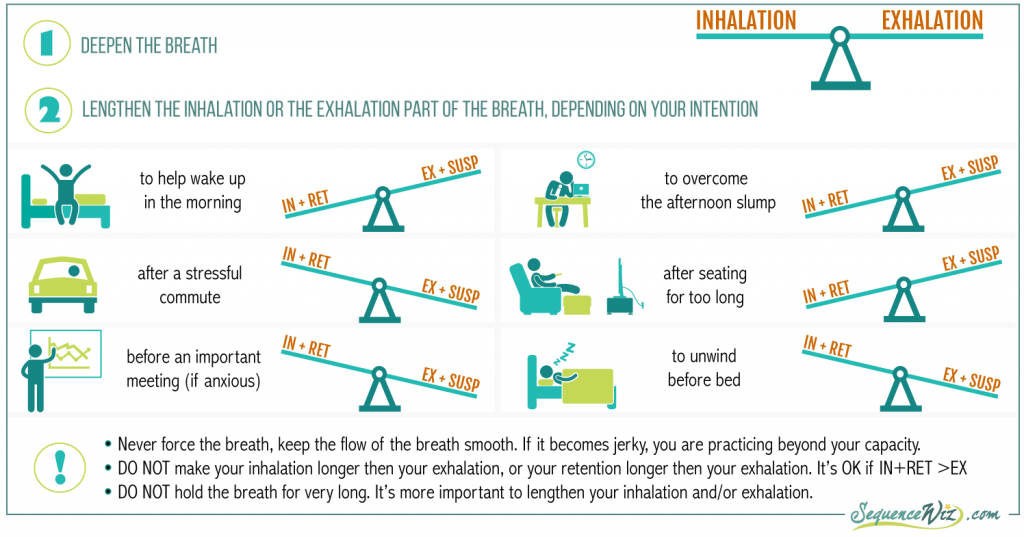 So it appears that ratio work would help stimulate the vagus nerve short-term (during the practice) and increase vagal tone long-term (if you do it consistently). This is very exciting. But, as my teacher likes to say, don’t take my word for it. Try it out and find out for yourself. All you have to lose is stress and chronic inflammation ☺
So it appears that ratio work would help stimulate the vagus nerve short-term (during the practice) and increase vagal tone long-term (if you do it consistently). This is very exciting. But, as my teacher likes to say, don’t take my word for it. Try it out and find out for yourself. All you have to lose is stress and chronic inflammation ☺
Next, we talk about another area that the vagus innervates and we have control over – your vocal cords. What does sound have to do with stimulating the vagus nerve? Find out here >
References
1. Hacking the nervous system by Gaia Vince (Mosaic, the science of life)



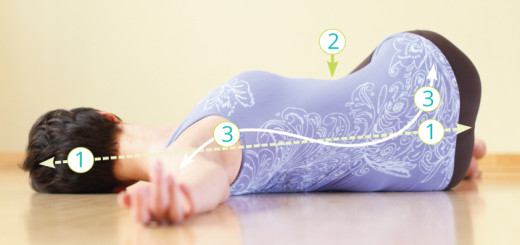
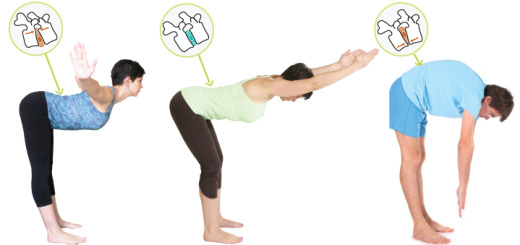
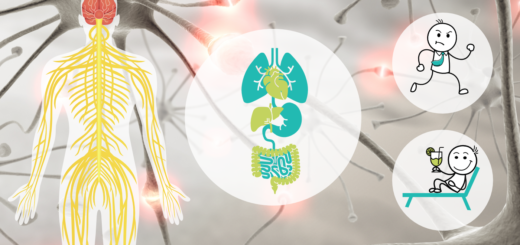















great reminder. Thanks, Olga.
My beloved Olga, I am looking forward to your Wednesday’s posts
10-times more than a child is looking forward to receive the Christmas presents. <3
Thank you.
:)))))
Love all your info! Thanks.
Brilliant breath blog!
Yesssss! Thank youuuu!
I love Olga’s articles. It is very helpful to understand how all aspects of yoga is beneficial to one’s well being .
I’ve been meaning to post a comment for a long time. Every time I read one of your articles, I feel my whole body settle into it and my mind becomes a sponge. It makes all my years of training in Viniyoga come together in a more profound way and I begin to connect dots I hadn’t connected before. Thank you so much for sharing your wisdom, knowledge and experience. Your passion is contagious!
Hi Shelley! Thank you so much for your wonderful comment, it means a lot to me, especially coming from a fellow viniyogi 🙂 This is what viniyoga keeps doing for me, too – connecting the dots of seemingly unrelated information into an integrated whole, all organized around the Panchamaya model. I like to think of it as a kaleidoscope – you turn it a certain way and all of the sudden the random pieces of colored glass come together to form a beautiful harmonious pattern. I am very happy to hear that some of my articles “turn the kaleidoscope” for you, so to speak!
Once again, a perfect companion to my Yoga Therapy studies on the nervous system. I just finished teaching a series on the Koshas in my yoga classes and will definitely include this in the Anna, Prana, and Manomaya Koshas next time. You are so respected and loved!
Hi Olga !
I do not now if it’s “normal” but I can breath out for such a long time and stay there holding the breath with empty lungs for so long ! On the contrary I have some problems with breathing in, it’s like the intake of air is never enough…
great site yours
Hi Josè! For most people exhalation is easier then the inhalation, but usually it is not such a dramatic difference 🙂 Sounds like it would be useful for you to work on gradual extension of the inhale to bring more balance into the system because we know how important deep balanced breathing is. http://sequencewiz.org/2014/06/18/breath-in-yoga-western-view/
While I respect the authors research efforts on this topic, and overall it is compiled and presented nicely, I have a concern based on years of heart rate variability research and training … parasympathetic activation is not as simple as slowing the exhale and post-exhale pause. Consistently I see that slowing much past 6-7 seconds exhale and 0.5-1 second pause pushes people out of parasympathetic coherence into sympathetic dominance and adverse effects could ensue. Caution is urged below 5.5-5.0 breaths/minute and a 1:2 ratio with 0.5 pausing between both phases especially in persons with chronic health concerns, high stress, PTSD and anxiety, etc
Hi Matthew, thank you for your comment – I completely agree! With anybody (but especially with students who have serious health issues) it is best to begin very slowly with investigating where they are with their breath at the moment. For many beginning students just helping them become aware of their breath is a huge step forward. This article outlines some general ideas of what’s possible, but specific applications will depend on a specific student. And the general advise is, of course, to NEVER force the breath past one’s capacity.
Hi Olga, Thanks and Question:
Thank you for this clear, practical article. What you describe lines up with my experience in my own body and life — including many years of yoga, pranayama, meditation, swimming, running, bicycle racing, etc. Question:
What is your source/citation for this statement: “Apparently, the vagal tone is congenital to some degree (you might be born a “glass-half-full person” indicating a high vagal tone) and to some degree it can be acquired.” [Congential = present from birth (especially of a disease or physical abnormality) e.g.,
a congenital malformation of the heart.] Is there any scientific/systematic study of nature vs. nurture when it comes to vagal tone? Seems much more likely to reflect life experiences. Aside from scientific study, what’s your experience? Have you ever personally worked with anyone who has not experienced beneficial results from wise training of their breathing? Have you encountered (or learned about) anyone who has not been able to acquire a higher vagal tone? Thanks for clarifying.
Hi Carolyn, thank you for your comment! I came across that statement (about congenital vs acquired vagal tone) in one of the articles that I mentioned in my post, but now, of course, I don’t remember which one 🙂 This aligns pretty well with my experience that some people are naturally able to bounce back from challenging experiences more easily then others. I attributed it to temperament before, but now I think that both vagal tone and hormonal fluctuations might have something to with it. Personally I have never seen a person who couldn’t be helped in one way or the other by intelligent breath training (if they want to be helped, of course 🙂 It might look/feel different for different people, but certainly improvement is possible for anyone (I think).
I teach meditative drawing and love this article. I have shared it with my students. Thank you.
Olga, obrigada! Sempre desconfiei de todos esses equívocos nas práticas de ásana, fui vítima de muitas lesões ao longo do tempo como professora de Yoga. O seu blog é uma bênção para mim. Muito obrigada. Diva Paiva
Hi, Olgakabel,
It is a very interesting article on yoga. Breath, vagal tone and hormonal are closely linked subject. I think further research work is necessary to measure the ratio of exhalation and inhalation which will give beneficial results to everyone. Thank you.
Thank you! I love your blog- wonderful synthesis of information! – from a fellow viniyogi <3
Thank you Mary!
Just what I needed to read. Essential information clearly expressed. Thanks for a great article.
Very well explained and important!
Thank you, Eunice!